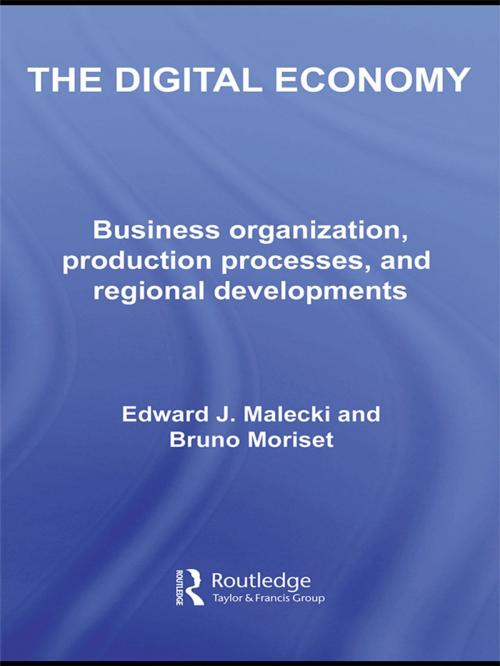The Digital Economy
Business Organization, Production Processes and Regional Developments
Nonfiction, Science & Nature, Science, Earth Sciences, Geography, Social & Cultural Studies, Social Science, Human Geography, Computers, Internet, Electronic Commerce| Author: | Edward J. Malecki, Bruno Moriset | ISBN: | 9781134154173 |
| Publisher: | Taylor and Francis | Publication: | December 7, 2007 |
| Imprint: | Routledge | Language: | English |
| Author: | Edward J. Malecki, Bruno Moriset |
| ISBN: | 9781134154173 |
| Publisher: | Taylor and Francis |
| Publication: | December 7, 2007 |
| Imprint: | Routledge |
| Language: | English |
Information technologies (IT) shape economic space, but we have no clear map of the cyber economy since the "digital revolution" began in the early 1970s.
The Digital Economy offers an up-to-date, critical synthesis that links the various aspects of the digital or cyber economy from the perspective of real firms. A geographic approach emphasizes how IT has made businesses less dependent on locational constraints, and the tangible effects on places and regions are placed at the core of the analysis. Case studies of companies, including Amazon, Dell, Li & Fung, and Volvo, demonstrate that the geography of digitally-driven production is the outcome of both dispersion and agglomeration dynamics. Global corporations are shown to have footprints that ignore – to some degree – distance and time, yet creative and coordinating activities remain anchored in urban innovative ecosystems such as Silicon Valley and Bangalore. These trends have been made possible by the development of a worldwide and integrated telecommunications network, whose unequal presence dictates the capabilities of places and communities to be connected to the global economy. However, the threat of the digital divide must not be overstated. In cities, rural areas, and emerging countries, local development is wrapped up in human capital, rather than technology.
This engaging and accessible text describes and explains the patterns and dynamics of today’s digital economic space. The effects on places and regions and the people in them are at the core of the authors’ analysis, illustrated by many real examples. This book will be useful to anyone studying business and management, geography and information and communication studies.
Information technologies (IT) shape economic space, but we have no clear map of the cyber economy since the "digital revolution" began in the early 1970s.
The Digital Economy offers an up-to-date, critical synthesis that links the various aspects of the digital or cyber economy from the perspective of real firms. A geographic approach emphasizes how IT has made businesses less dependent on locational constraints, and the tangible effects on places and regions are placed at the core of the analysis. Case studies of companies, including Amazon, Dell, Li & Fung, and Volvo, demonstrate that the geography of digitally-driven production is the outcome of both dispersion and agglomeration dynamics. Global corporations are shown to have footprints that ignore – to some degree – distance and time, yet creative and coordinating activities remain anchored in urban innovative ecosystems such as Silicon Valley and Bangalore. These trends have been made possible by the development of a worldwide and integrated telecommunications network, whose unequal presence dictates the capabilities of places and communities to be connected to the global economy. However, the threat of the digital divide must not be overstated. In cities, rural areas, and emerging countries, local development is wrapped up in human capital, rather than technology.
This engaging and accessible text describes and explains the patterns and dynamics of today’s digital economic space. The effects on places and regions and the people in them are at the core of the authors’ analysis, illustrated by many real examples. This book will be useful to anyone studying business and management, geography and information and communication studies.















